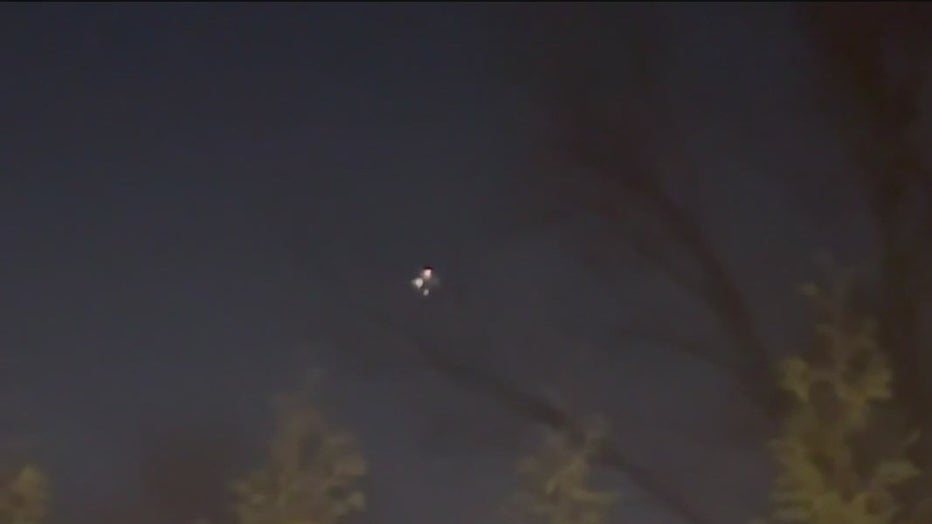NJ mayor links drone sightings to missing radioactive material

NJ mayor says there's radioactive material missing amid mysterious drone sightings
Belleville Mayor Michael Melham revealed that state police issued an alert regarding missing radioactive material, suggesting a potential connection to the recent mysterious drone sightings.
NEW YORK - As officials continue to investigate the origins of mysterious drones spotted over the skies of New Jersey, Belleville Mayor Michael Melham suggested that they might be connected to missing radioactive material.
"We know we have drones flying in a grid-like pattern. In my opinion, they're looking for something. What might they be looking for? Maybe that's radioactive material," Melham said on Good Day New York.
According to a Nuclear Regulatory Commission alert, radioactive material went missing on Dec. 2.
"It was a shipment. It arrived at its destination. The container was damaged, and it was empty," Melham said.
Watch Mayor Melham's full interview with Curt Menefee and Rosanna Scotto in the media player above.
Melham on drones
Melham told Good Day. "Information has not been forthcoming, and it's this lack of transparency…that's doing nothing but fueling conspiracy theories online,"
When asked about his thoughts on what the drones could be, Melham responded, "I can tell you what it's not."

"We know for a fact it's not little green men." He added, Melham said the drones were flying in a grid and that they could likely be looking for something.
"Maybe that's radioactive material," Melham said.
"And more than likely, it's not a foreign adversary, because they would be able to figure out how to turn off the blinking lights," he said.
Missing radioactive material in NJ

Trump says he'll consider pardoning Mayor Adams
President-elect Donald Trump said he’d consider pardoning indicted New York City Mayor Eric Adams during a Monday morning news conference from his Mar-a-Lago, Florida, resort. FOX 5 NY's Robert Moses has the details.
The United States Nuclear Regulatory Commission (NRC) reported radioactive material lost in transit in Newfield, New Jersey, on December 3, 2024. The material, identified as a Ge-68 pin source (Eckert & Ziegler model HEGL-0132) with approximately 0.267 mCi of activity, was shipped for disposal but never arrived intact.
According to the NRC, "The shipping container arrived at its destination damaged and empty. The licensee has filed a claim with the shipper. If the source is not located within 30 days, the licensee will follow up with a full written report to include root cause(s) and corrective actions."
What kind of radioactive material was it?

The NRC categorized the material as "Less than IAEA Category 3," meaning it’s unlikely to cause permanent injury. However, unshielded material could potentially cause temporary harm if mishandled or in close proximity for an extended period.
The NRC explains that sources categorized as "Less than IAEA Category 3" contain minimal radioactive material. While unlikely to cause permanent injury, mishandling or prolonged exposure to these sources, such as moisture density gauges, could temporarily harm individuals over several weeks.
The radioactive material was licensed to the Nazha Cancer Center.
Drone flying in New Jersey
Several sightings of mysterious drones have been reported in parts of New Jersey in recent weeks. Sightings were reported from down the Jersey Shore up to Sussex and Bergen counties.
The Picatinny Arsenal military base has even confirmed several sightings of unauthorized drones flying over its airspace in recent weeks.
New Jersey Gov. Phil Murphy and Secretary of Homeland Security Alejandro Mayorkas briefed the congressional delegation last week, calling on the federal government for more answers.
"It's really frustrating that we don't have more answers as to where they were coming from and why they're doing what they're doing," Murphy said.
How to know if there's a drone

Trump comments on NJ drone mystery
President-elect Donald Trump said "the government knows what is happening" when asked about the New Jersey drone mystery during a wide-ranging Monday morning news conference. FOX 5 NY's Briella Tomassetti has the latest.
Experts who study unmanned aircraft systems, better known as drones, say it can be tough to tell from miles away. But there are clues.
Lights:
- Planes and helicopters have flashing lights, typically including at least one red anti-collision light and steady red and green navigation lights.
- Drones may have multiple lights, but they are smaller and the lights are closer together, making it harder to gauge distance at night.
Noise:
- Drones are quieter with a higher-pitched buzzing sound compared to planes or helicopters, though larger drones can be louder.
Identification:
- Drones heavier than half a pound may have an identifying number, but it’s difficult to see at night and requires close proximity during the day.
Movement:
- Drones can make sharp stops, pivot 90 degrees, and reverse course, unlike planes or helicopters which move smoothly.
Altitude:
- Most drones operate below 400 feet, in compliance with federal regulations.

